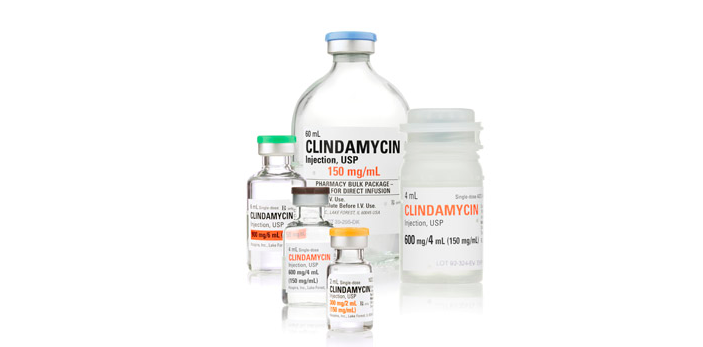Another effective antibiotic in your toolbox
How It Works
Clindamycin is an antibiotic in the lincosamide class, active against gram positive bacteria and anaerobes. It binds to the large subunit (50S) of the bacterial ribosome and inhibits new peptide-peptide bond formation. It is bacteriostatic in most cases, though can be bactericidal at high concentrations for certain species. Because of its ability to inhibit translation, clindamycin at sub-inhibitory concentrations can reduce production of bacterial toxins in cases of streptococcal or staphylococcal toxic shock syndrome or in necrotizing infections. By contrast, beta-lactams can actually induce production of alpha toxin in S. aureus [1]. Clindamycin can therefore work synergistically with bacterial cell-wall inhibiting agents such as penicillins, cephalosporins, and vancomycin for toxin-synthesizing gram positive species. Clindamycin cannot penetrate gram negative organisms [2], so it is not active against them and does not affect gram negative endotoxin production.
Major Indications
The primary role for clindamycin is in skin and soft tissue infections. It is FDA-approved for use in SSTIs due to streptococcus or MSSA, toxic shock syndrome, impetigo, S. aureus osteomyelitis, pyomyositis, and amnionitis. It is also used off-label for anthrax, babesiosis, animal bite wounds (along with a cephalosporin), malaria treatment, MRSA infections, Pneumocystis pneumonia, septic arthritis, and MRSA SSTIs [3]. For necrotizing SSTIs, clindamycin can be given along with cefotaxime for polymicrobial infections, though vancomycin and pipercillin-tazobactam are recommended as first line, empiric treatment [4]. If the necrotizing infection is known to be due to Clostridium perfringens or group A streptococcus, then clindamycin and penicillin IV are sufficient [4].
Clindamycin can also be used for other indications in patients who have severe penicillin allergies. These include treatment of group A streptococcal pharyngitis, pelvic inflammatory disease, and necrotizing skin infections [3]. Topical clindamycin can be used for acne and intra-vaginally for treatment of bacterial vaginosis.
Notable History
Clindamycin has been available since 1968 after it was synthesized as a derivative of lincomycin, which is a natural product made by Streptomyces lincolnensis, an actinobacterium.
Recently In The News For
A 2015 NEJM article5 found no difference in treatment efficacy or in complication rates between clindamycin and trimethoprim-sulfamethoxazole for treatment of uncomplicated cellulitis and abscess. Using an intention-to-treat analysis, cure rates were 80.3% in the clindamycin group, and 77.7% in the TMP-SMX group (p=0.52). The study included both children and adults with a total of 524 patients, of whom 53.4% had cellulitis, 30.5% had an abscess, and 15.6% had a mixed infection. 41.4% of the cultures grew S. aureus, of which 77% were methicillin-resistant. However, the latest IDSA SSTI guidelines for treatment of mild abscesses recommend incision and drainage only, with no antibiotics [4].
Adverse Events
Common adverse reactions include nausea, vomiting, diarrhea, and abdominal pain. Anaphylactoid reactions and DRESS syndrome (drug reaction with eosinophilia and systemic symptoms) can also occur.
Cautions
Clindamycin carries a black box warning for the risk of pseudomembranous colitis from C. difficile Associated Diarrhea (CDAD), which can be fatal. CDAD can occur during treatment with clindamycin, but has also been reported over 2 months after clindamycin use. It is important to take a good antibiotic history in the evaluation of patients with diarrhea to assess for CDAD risk. Because of the high risk of CDAD, other antibiotics should be considered before using clindamycin.
Dosing & Adjustments
Clindamycin is given IV at 600-900mg Q8hr for severe infections. For mild infections, it can be given at 300-400mg PO QID or 450mg TID. Clindamycin has about 90% oral bioavailability, making it an attractive options for patients who do not have an IV, have limited IV access sites, and those who can be discharged on oral medications.
Special Considerations
Clindamycin is pregnancy class B, and is considered safe in breastfeeding women, as it is minimally excreted in the breast milk. Tell patients to take an 8 oz glass of water with each clindamycin dose. That helps prevent esophagitis, which is a common adverse reaction if the pill is taken with only a small sip of water.
Cost
A single dose of 600mg IV clindamycin costs from $3-$15. An oral clindamycin course of 300mg QID for 10 days costs around $150. 1% topical clindamycin costs $50-$80 for a 30g tube, while vaginal 2% clindamycin costs over $100 for a 40g tube.
REFERENCES
- Ohlsen K, Ziebuhr W, Koller KP, Hell W, Wichelhaus TA, Hacker J. Effects of subinhibitory concentrations of antibiotics on alpha-toxin (hla) gene expression of methicillin-sensitive and methicillin-resistant staphylococcus aureus isolates. Antimicrob Agents Chemother. 1998;42(11):2817-2823.
- Leclercq R, Courvalin P. Intrinsic and unusual resistance to macrolide, lincosamide, and streptogramin antibiotics in bacteria. Antimicrob Agents Chemother. 1991;35(7):1273-1276.
- Lexicomp. Clindamycin (systemic): Drug information. UpToDate Web site. http://www.uptodate.com/contents/clindamycin-systemic-drug-information. Accessed 07/16, 2015.
- Stevens DL, Bisno AL, Chambers HF, et al. Practice guidelines for the diagnosis and management of skin and soft tissue infections: 2014 update by the infectious diseases society of america. Clin Infect Dis. 2014;59(2):147-159.
- Miller LG, Daum RS, Creech CB, et al. Clindamycin versus trimethoprim-sulfamethoxazole for uncomplicated skin infections. N Engl J Med. 2015;372(12):1093-1103.








